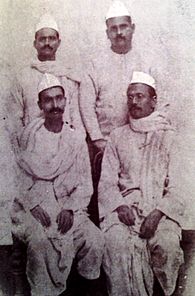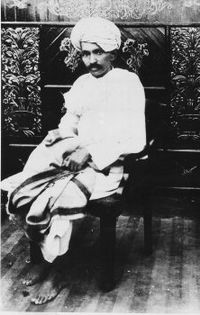- Champaran and Kheda Satyagraha
-
The first Satyagraha revolutions inspired by Mahatma Gandhi in the Indian Independence Movement occurred in Kheda district of Gujarat and the Champaran district of Bihar between the years of 1918 and 1919. Champaran Satyagraha was the first to be started but the word Satyagraha was used for the first time in Anti Rowlatt agitation.
Contents
Campota, Bihar
In Champaran, a district in state of Bihar, tens of thousands of landless serfs, indentured laborers and poor farmers were forced to grow indigo and other cash crops instead of the food crops necessary for their survival. These goods were bought from them at a very low price. Suppressed by the ruthless militias of the landlords (mostly British), they were given measly compensation, leaving them mired in extreme poverty. The villages were kept extremely dirty and unhygienic, and alcoholism, untouchability and purdah were rampant. Now in the throes of a devastating famine, the British levied an oppressive tax which they insisted on increasing in rate. Without food and without money, the situation was growing progressively unlivable and the peasants in Champaran revolted against indigo cultivation in 1914 (at Pipra) and 1916(Turkaulia) and Raj Kumar Shukla took Mahatma Gandhi to Champaran and the Champaran Satyagraha began. Gandhi arrived in Champaran with a team of[1] eminent lawyers, comprising[2] of Brajkishore Prasad, Rajendra Prasad, Anugrah Narayan Sinha and others including Acharya kripalani.[3]
Kheda, Gujarat
In Kheda, a district of villages and small towns in Gujarat, the peasants mostly owned their own lands, and were economically better-off than their compatriots in Bihar, although on the whole, the district was plagued by poverty, scant resources, the social evils of alcoholism and untouchability, and overall British indifference and hegemony.[citation needed]
However, a famine had struck the district and a large part of Gujarat, and virtually destroyed the agrarian economy. The poor peasants had barely enough to feed themselves, but the British government of the Bombay Presidency insisted that the farmers not only pay full taxes, but also pay the 23% increase stated to take effect that very year.
Gandhi's solution
While many civic groups sent petitions and published editorials, Gandhi proposed satyagraha - non-violence, mass civil disobedience. While it was strictly non-violent, Gandhi was proposing real action, a real revolt that the oppressed peoples of India were dying to undertake.
Gandhi also insisted that neither the protestors in Bihar nor in Gujarat allude to or try to propagate the concept of Swaraj, or Independence. This was not about political freedom, but a revolt against abject tyranny amidst a terrible humanitarian disaster. While accepting participants and help from other parts of India, Gandhi insisted that no other district or province revolt against the Government, and that the Indian National Congress not get involved apart from issuing resolutions of support, to prevent the British from giving it cause to use extensive suppressive measures and brand the revolts as treason.
In Champaran
 (Sitting L to R)Dr Rajendra Prasad and Dr Anugrah Narayan Sinha during Mahatama Gandhi's 1917 Champaran Satyagraha
(Sitting L to R)Dr Rajendra Prasad and Dr Anugrah Narayan Sinha during Mahatama Gandhi's 1917 Champaran Satyagraha
Gandhi established an ashram in Champaran, organizing scores of his veteran supporters and fresh volunteers from the region. He organized a detailed study and survey of the villages, accounting the atrocities and terrible episodes of suffering, including the general state of degenerate living.
Building on the confidence of villagers, he began leading the clean-up of villages, building of schools and hospitals and encouraging the village leadership to undo purdah, untouchability and the suppression of women. He was joined by many young nationalists from all over India, including Brajkishore Prasad, Rajendra Prasad, Anugrah Narayan Sinha, Ram Navami Prasad and Jawaharlal Nehru.
But his main assault came as he was arrested by police on the charge of creating unrest and was ordered to leave the province. Hundreds of thousands of people protested and rallied outside the jail, police stations and courts demanding his release, which the court unwillingly did. Gandhi led organized protests and strike against the landlords, who with the guidance of the British government, signed an agreement granting more compensation and control over farming for the poor farmers of the region, and cancellation of revenue hikes and collection until the famine ended. It was during this agitation, that Gandhi was addressed by the people as Bapu (Father) and Mahatma (Great Soul).
In Kheda
In Gujarat, Gandhi was only the spiritual head of the struggle. His chief lieutenant, Sardar Vallabhbhai Patel and a close coterie of devoted Gandhians, namely Narhari Parikh, Mohanlal Pandya and Ravi Shankar Vyas toured the countryside, organized the villagers and gave them political leadership and direction. Many aroused Gujaratis from the cities of Ahmedabad and Vadodara joined the organizers of the revolt, but Gandhi and Patel resisted the involvement of Indians from other provinces, seeking to keep it a purely Gujarati struggle.
Patel and his colleagues organized a major tax revolt, and all the different ethnic and caste communities of Kheda rallied around it. The peasants of Kheda signed a petition calling for the tax for this year to be scrapped in wake of the famine. The government in Bombay rejected the charter. They warned that if the peasants did not pay, the lands and property would be confiscated and many arrested. And once confiscated, they would not be returned even if most complied. None of the villages flinched.
The tax withheld, the government's collectors and inspectors sent in thugs to seize property and cattle, while the police forfeited the lands and all agrarian property. The farmers did not resist arrest, nor retaliate to the force employed with violence. Instead, they used their cash and valuables to donate to the Gujarat Sabha which was officially organizing the protest.
The revolt was astounding in terms of discipline and unity. Even when all their personal property, land and livelihood were seized, a vast majority of Kheda's farmers remained firmly united in the support of Patel. Gujaratis sympathetic to the revolt in other parts resisted the government machinery, and helped the shelter the relatives and property of the protesting peasants. Those Indians who sought to buy the confiscated lands were ostracized from society. Although nationalists like Sardul Singh Caveeshar called for sympathetic revolts in other parts, Gandhi and Patel firmly rejected the idea.
The Government finally sought to foster an honorable agreement for both parties. The tax for the year in question, and the next would be suspended, and the increase in rate reduced, while all confiscated property would be returned.
Gujaratis also worked in cohesion to return the confiscated lands to their rightful owners. The ones who had bought the lands seized were influenced to return them, even though the British had officially said it would stand by the buyers.
See also
- Indian Independence Movement, Indian Nationalism
- My Autobiography, Or The Story Of My Experiments With Truth (1929) by M.K. Gandhi
- Mahatma Gandhi, Gandhism, Satyagraha, Sardar Vallabhbhai Patel
References
- ^ aicc. "SATYAGRAHA MOVEMENT OF MAHATMA GANDHI". aicc. Archived from the original on 2006-12-06. http://web.archive.org/web/20061206050856/http://www.aicc.org.in/satyagraha_laboratories_of_mahatma_gandhi.htm. Retrieved 2006-12-08.
- ^ aicc. "SATYAGRAHA MOVEMENT". aicc. Archived from the original on 2008-06-25. http://web.archive.org/web/20080625022557/http://www.aicc.org.in/satyagraha_laboratories_of_mahatma_gandhi.htm. Retrieved 2008-07-08.
- ^ Brown, Judith Margaret (1972). Gandhi's Rise to Power, Indian Politics 1915-1922: Indian Politics 1915-1922. New Delhi: Cambridge University Press Archive. pp. 384. ISBN 978-0521098731.
Further reading
- Gandhi's first step: Champaran movement, by Shankar Dayal Singh. B.R. Pub. Corp., 1994. ISBN 8170188342.
- Peasant Nationalists of Gujarat : Kheda District, 1917-1934 by David Hardiman
- Patel: A Life by Rajmohan Gandhi
- See Day to Day with Gandhi (volume 1), some original documents about the Kheda Satyagraha.
Mohandas Karamchand Gandhi Family Influences Life Civil rights movement in South Africa · Bardoli Satyagraha · Champaran and Kheda Satyagraha · Non-cooperation · Chauri Chaura · Purna Swaraj · Salt Satyagraha · Vaikom Satyagraha · Poona Pact · Quit India · AssassinationPhilosophy Associates Vinoba Bhave · Vallabhbhai Patel · Mirabehn · C. F. Andrews · Narhari Parikh · Ravi Shankar Vyas · Mohanlal Pandya · Mahadev Desai · Abbas Tyabji · Khan Abdul Ghaffar Khan · Dada Dharmadhikari · J. C. Kumarappa · Hermann KallenbachLegacy Influenced Martin Luther King, Jr. · James Lawson · James Bevel · Nelson Mandela · Steve Biko · Aung San Suu Kyi · Maria Lacerda de Moura · Lanza del VastoMemorials at Kanyakumari · Martin Luther King, Jr., National Historic Site · Pietermaritzburg · Rajghat · National Gandhi Museum · Gandhi SmritiMemorial observances  Category
CategoryTax resistance Topics Conscientious objection to military taxation · History of tax resistance · List of tax resisters · Tax noncompliance · Tax revoltMethods Organizations Addiopizzo · Aide-toi, le ciel t'aidera · All Britain Anti-Poll Tax Federation · Anti-Poll Tax Unions · Association of Real Estate Taxpayers · Committee for Non-Violent Action · Irish National Land League · National Campaign for a Peace Tax Fund · National War Tax Resistance Coordinating Committee · Northern California War Tax Resistance · Pagal Panthis · Peacemakers · Women's Tax Resistance LeagueMedia An Act of Conscience · Civil Disobedience · Clericis laicos · The Cold War and the Income Tax: A Protest · Vyborg ManifestoCampaigns 1300s1500sRappenkrieg1600sRevolt of the va-nu-pieds · Revolt of the papier timbré1700s1800s1900sDog Tax War · Champaran and Kheda Satyagraha · Poplar Rates Rebellion · Mau movement · Igbo Women's War · Salt March · Beit Sahour · Poll Tax RiotsRelated topics Categories:
Wikimedia Foundation. 2010.







